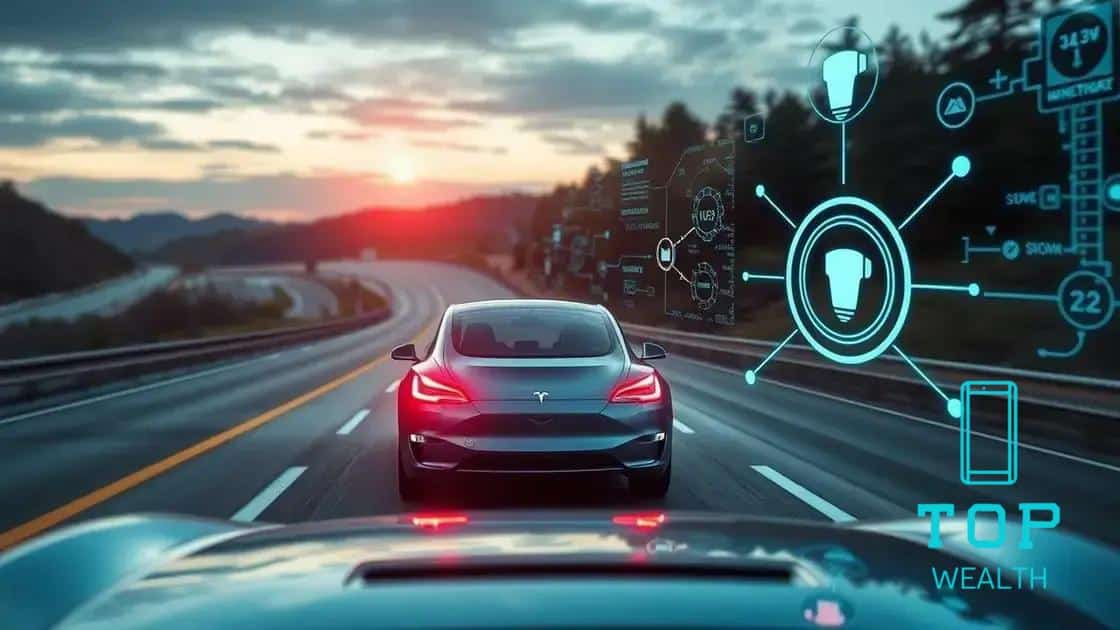Tesla advances self-driving data analysis

Tesla advances self-driving data analysis by leveraging real-time driving data to enhance safety features, improve vehicle performance, and integrate future technologies like AI and V2X communication for smarter navigation.
Tesla advances self-driving data analysis and it’s fascinating how this impacts the way we think about autonomous vehicles. Ever wondered what goes on behind the scenes? Let’s dive into this intriguing world.
The significance of data in self-driving technology
The importance of data in self-driving technology cannot be overstated. Data is the backbone of autonomous vehicles, driving their understanding of the environment and improving safety features.
Data collection starts when a vehicle is on the road. Sensors capture vital information about the surroundings, such as road conditions and the behavior of other drivers. This information is crucial for the vehicle to make informed decisions while navigating.
Types of Data Collected
There are several types of data that self-driving cars rely on:
- Sensor Data: This includes information from cameras, LIDAR, and radar systems that detect obstacles and track movements.
- Vehicle Performance Data: Information regarding speed, acceleration, and braking helps in assessing how well the vehicle performs.
- Traffic Data: Data from traffic signals and patterns assists in navigation and understanding when to stop or proceed.
- Environmental Data: Weather conditions, such as rain or fog, are also analyzed to adapt driving behavior.
By analyzing such a wide range of data, self-driving cars can learn from experiences and improve their algorithms. Machine learning plays a critical role in this process. It enables cars to identify patterns in driving behavior, making them safer and more efficient over time.
Tesla is known for its extensive data collection methods, which help refine its self-driving features constantly. This continuous learning approach means the more a vehicle drives, the smarter it becomes. For example, incidents that occur during driving are logged and analyzed to enhance the car’s ability to respond to similar situations in the future.
As technology evolves, the volume of data collected is only expected to increase. This influx of information will enhance the algorithms used in self-driving systems, making them more reliable and robust. It’s fascinating to think about how much these vehicles can learn from mere driving experiences, reshaping our understanding of technology and transportation for years to come.
How Tesla collects and analyzes driving data

Understanding how Tesla collects and analyzes driving data is key to grasping the advancements in self-driving technology. Every drive in a Tesla provides valuable insights that enhance the overall driving experience.
Tesla vehicles are equipped with sophisticated hardware and software that work together to gather information. Sensors, cameras, and radar systems allow the car to perceive its surroundings in real-time, collecting data on everything from traffic patterns to road conditions.
Data Collection Methods
Here are some methods Tesla uses to gather driving data:
- Onboard Sensors: These capture detailed information about the car’s environment and help it navigate safely.
- Real-Time Feedback: The vehicle sends data back to Tesla’s servers while driving, allowing for immediate analysis and improvements.
- Driver Behavior Monitoring: By observing how drivers interact with the vehicle, Tesla improves its autonomous features.
- Fleet Learning: All Tesla cars share data, which allows the entire fleet to learn from each other’s experiences.
Once the data is collected, it is sent to Tesla’s cloud servers for deeper analysis. In this stage, algorithms process the data, highlighting trends and identifying areas for improvement. The system can detect patterns in driving styles and adjust vehicle responses accordingly. This feedback loop is powerful; as more cars operate on the road, they collectively learn from the data.
The analysis not only enhances self-driving capabilities but also improves safety features. For example, if a particular scenario results in a near-accident, Tesla reviews the data to understand what happened and make necessary adjustments to the software. Learning from real-world situations helps prepare the vehicles for future challenges, making them more reliable over time.
By continuously collecting and analyzing this data, Tesla ensures that its cars are not only smart but also more capable of adapting to the ever-changing driving environment. As technology progresses, the importance of such data will only grow, shaping the future of autonomous driving.
Real-world impact of Tesla’s data analysis
The real-world impact of Tesla’s data analysis is significant and wide-ranging. It affects how vehicles operate, enhance safety protocols, and improve user experiences.
As Tesla gathers and analyzes driving data, the insights gained lead to better software updates. Each update can adjust how the vehicle responds to various driving scenarios, thus improving safety and performance.
Enhancing Safety Features
One major outcome of Tesla’s data analysis is the enhancement of safety features. Here are some crucial safety improvements:
- Autopilot Adjustments: Continuous learning allows the autopilot to navigate tricky situations more effectively.
- Collision Avoidance Systems: Data analysis reveals patterns that help the car avoid potential accidents.
- Driver Alerts: Real-time data can prompt alerts for driver fatigue or distraction, ensuring safer driving habits.
- Emergency Braking: Enhanced algorithms react faster to sudden obstacles, minimizing accidents.
The data-driven approach also contributes to better vehicle dynamics. Each time a Tesla is on the road, it improves its understanding of how to drive efficiently through various environments. For instance, if multiple Teslas report challenges at a specific intersection, the system learns to handle that situation better in the future.
The impact goes beyond individual vehicles; it extends to the overall driving ecosystem. As more Tesla cars are on the roads, the collective data helps shape urban planning and traffic management. For example, city planners could use this data to optimize traffic light patterns or understand peak traffic times, ultimately improving the flow of the entire transportation system.
Moreover, the data analysis can lead to innovations in energy consumption. By analyzing driving patterns, Tesla can assist drivers in maximizing battery efficiency for electric vehicles. This means drivers can make informed choices about charging and driving habits, contributing to greener transportation practices.
Challenges in self-driving data processing
One of the key challenges in self-driving data processing is managing the vast amounts of information generated by sensors and cameras. Tesla vehicles produce terabytes of data with every ride, making it crucial to have efficient systems in place to analyze and learn from this data.
While processing this data, machines must accurately interpret the environment around them. This involves distinguishing between various objects on the road, such as pedestrians, cars, and traffic signals. A small error in perception can lead to dangerous situations.
Data Quality and Reliability
The quality of data collected is paramount. Here are some issues that can arise:
- Sensor Limitations: Sensors can be affected by weather conditions such as fog, rain, or snow, leading to inaccurate readings.
- Data Noise: Not all collected data is relevant. Separating valuable information from noise requires advanced filtering techniques.
- Processing Speed: Real-time decisions depend on swift data processing. Delays can reduce the effectiveness of autonomous features.
- System Integration: Merging data from various sensors into a cohesive understanding is complex and can lead to inconsistencies.
Another significant challenge is the need for constant learning. The data gathered must not only improve current systems but also adapt to new environments and driver behaviors. For instance, a car that drives in a city may face different challenges than one that operates in rural areas.
Tesla vehicles continuously learn from each drive, but this requires ongoing adjustments to algorithms that analyze driving behavior. Machine learning models must be regularly updated to ensure they remain effective and accurate. This process can be resource-intensive and requires collaboration among engineers, data scientists, and AI specialists.
Moreover, ethical considerations come into play when handling driving data. Ensuring data privacy and security is critical. Tesla must take measures to protect users’ information while still leveraging data to improve self-driving capabilities. Balancing innovation with ethical responsibilities creates an additional layer of complexity in data processing.
Future technologies for improved self-driving capabilities
The future of self-driving capabilities is bright, with several exciting technologies on the horizon. As advancements in artificial intelligence and machine learning continue, they will play a crucial role in enhancing the performance of autonomous vehicles.
One of the key areas of development involves improving sensor technology. New sensors are being designed to provide better resolution and accuracy. This means that self-driving cars can perceive their environments more effectively, even in challenging conditions such as heavy rain or fog.
Advancements in AI Algorithms
As AI continues to evolve, so do the algorithms that power self-driving systems. Here are some potential advancements:
- Deep Learning: This approach will enable cars to learn from vast datasets, making driving decisions based on real-time analysis.
- Predictive Analytics: Future systems will anticipate actions of other road users, enhancing safety by acting before potential hazards arise.
- Enhanced Object Recognition: Improving how vehicles recognize and categorize objects on the road will reduce errors in interpretation.
- Adaptive Learning: Cars will dynamically adjust their learning based on the environment, further refining their responses to unique scenarios.
Another exciting prospect is the integration of vehicle-to-everything (V2X) communication. This technology allows vehicles to communicate with each other and with infrastructure, such as traffic signals and road signs. With V2X, a Tesla could receive information about traffic congestion or road hazards ahead, allowing it to make informed decisions before reaching those areas.
Furthermore, electric and automated vehicles will benefit from developments in battery technology. These advancements will lead to longer ranges and faster charging times, making electric self-driving cars more practical for everyday use. Improved battery efficiency will also decrease the overall environmental impact, aligning with the global push for greener transportation.
Additionally, simulation technologies are advancing, enabling manufacturers to test self-driving algorithms in virtually created environments. This virtual testing can expose systems to a variety of scenarios without the risks associated with real-world testing. By using simulations, developers can ensure a broader range of situations is accounted for before deploying updates to the fleet.
FAQ – Frequently Asked Questions about Tesla’s Self-Driving Technology
What is the main benefit of Tesla’s data analysis?
Tesla’s data analysis enhances safety and performance in self-driving cars by learning from real-world driving experiences.
How do future technologies improve self-driving capabilities?
Future technologies such as advanced AI algorithms and V2X communication will enable cars to make smarter, more efficient driving decisions.
What challenges does Tesla face in data processing?
Tesla faces challenges in managing large data volumes, ensuring data quality, and making real-time decisions based on sensor inputs.
How does Tesla ensure data security for users?
Tesla prioritizes data security by implementing measures that protect user information while gathering insights for vehicle improvements.





